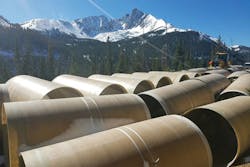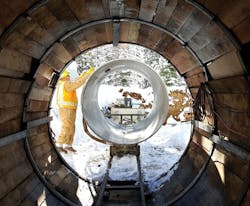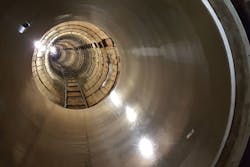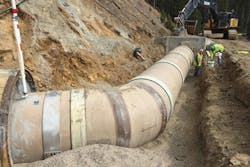Mountain Is No Obstacle for Pipeline Rehabilitation Project
By Erin Boudreaux
The Michigan Ditch was built before 1900 and is a 5.2-mile-long ditch system that carries mountain runoff into the water system for the City of Fort Collins, Colo., to utilize as reuse water. Michigan Ditch is located in the vicinity of Highway 14 at Cameron Pass, a 10,276-foot-elevation mountain pass in the Rocky Mountains. The pass is a gap between the south end of the Medicine Bow Mountains and the north end of the Never Summer Mountains and sits on the border between Jackson County and Larimer County. The area offers winter recreation activities such as snowshoeing, cross-country skiing and also scenic driving and wildlife viewing.
Fort Collins Utilities has transmountain water rights for conveying snow melt into its water system. Michigan Ditch, along with Joe Wright Reservoir, is a crucial part of the water storage and delivery system.
The Michigan Ditch is a combination of open waterway and pipelines. “Approximately 1,600 feet of the ditch still runs through the original wood stave pipe material, some of it exposed and still above grade,” said John Beckos, project manager with BT Construction Inc. of Henderson, Colo. “The Michigan Ditch Rehabilitation Project replaced a combination of open ditch and buried 54-inch ductile iron pipe through the section of the ditch known as ‘The Mudslide’.”
In 2015, movement of an ongoing slow-moving landslide that began years ago became so extreme that it changed the alignment of the pipe to an extent it could not be repaired with a cut and cover solution. In order to retain its water rights, Fort Collins Utilities determined that a repair of the collection system was necessary. After considering many options, a tunnel through the mountain was determined to be the best solution.
Field Versatility
A 765-foot-long curved tunnel was bored through the side of the mountain using a tunnel boring machine (TBM). The tunnel has an outside diameter of 96 inches and an initial support of steel rib and wood lagging. Following tunnel construction, 765 feet of 60-inch Hobas pipe was inserted into the primary tunnel to serve as the carrier pipe for the water. The pipe for the tunnel was manufactured with a stiffness class of SN 62, in 10-foot sections, with a flush joint configuration that was blocked into place and subsequently grouted. BT Construction was the installation contractor for the tunnel. Due to soil and ground conditions, the tunnel was designed with a slight curve. “It was determined that a 0.9-degree deflection for every ten-foot joint would match up quite well with the Flush Reline pipe (1.2 degrees max),” said Beckos.
The open cut section was installed by Hydro Construction of Fort Collins, Colo. This section consisted of 64 feet of pipe on the upstream side and 137 feet of pipe on the downstream side. These sections of pipe were also 60-inch pipe, stiffness class SN 46 and supplied in 10-foot sections. Three elbows were provided for the upstream and downstream angles.
“The elbows enabled the underground tunnel pipeline to be realigned to match up with the open cut ditch system,” explained Beckos.
Overcoming Obstacles
With the project location on a mountainside at such a high elevation, challenges were to be expected. “There was very limited staging area on the site,” said Beckos. Access from the delivery location on Highway 14 to the installation site is along a winding 2.5-mile-long, single-track road with an open ditch on one side and a drop off along the other. “Basically, the side of a mountain,” said Beckos. As portions of the open cut ditch were abandoned and filled in, small staging areas were created that could temporarily store Hobas pipe. In addition to the ten-foot sections being beneficial for maintaining the curve alignment, it was easier to maneuver the shorter sections on the narrow job site than the standard 20-foot lengths.
Project Delivery
Fort Collins Utilities uses an Alternative Product Delivery Method (APDS), which brings the owner, designer and contractor together from the start of the project. Through this process, they were able to complete the project ahead of schedule and under budget.
“Under the APDS, Utilities (owner) brought together Stantec Consulting (lead engineer), Lithos Engineering (tunnel engineer and onsite inspection), BT Construction (tunnel contractor), and Hydro Construction (open cut contractor) to develop the scope of the project,” stated Beckos. The team took the project from initial concept through the design and construction processes. “It was a very schedule-driven approach to get the Michigan Ditch reinstated before the start of the 2017 spring runoff,” he said. “I am happy to report that the team finished the project safely, on line and grade, on time and under budget.”
According to Owen Randall, P.E., chief engineer for Fort Collins Utilities, construction began in May 2016 and was completed by the end of October. Limited by the winter weather conditions in Colorado, completion of this project was crucial to allow full use of water rights by spring 2017. The original project cost was estimated at $8.5 million and the project was completed for around $7.3 million.
About the Author: Erin Boudreaux is marketing manager for Hobas Pipe USA.




